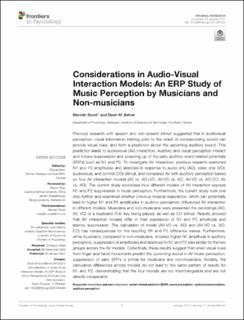| dc.description.abstract | Previous research with speech and non-speech stimuli suggested that in audiovisual perception, visual information starting prior to the onset of corresponding sound can provide visual cues, and form a prediction about the upcoming auditory sound. This prediction leads to audiovisual (AV) interaction. Auditory and visual perception interact and induce suppression and speeding up of the early auditory event-related potentials (ERPs) such as N1 and P2. To investigate AV interaction, previous research examined N1 and P2 amplitudes and latencies in response to audio only (AO), video only (VO), audiovisual, and control (CO) stimuli, and compared AV with auditory perception based on four AV interaction models (AV vs. AO+VO, AV-VO vs. AO, AV-VO vs. AO-CO, AV vs. AO). The current study addresses how different models of AV interaction express N1 and P2 suppression in music perception. Furthermore, the current study took one step further and examined whether previous musical experience, which can potentially lead to higher N1 and P2 amplitudes in auditory perception, influenced AV interaction in different models. Musicians and non-musicians were presented the recordings (AO, AV, VO) of a keyboard /C4/ key being played, as well as CO stimuli. Results showed that AV interaction models differ in their expression of N1 and P2 amplitude and latency suppression. The calculation of model (AV-VO vs. AO) and (AV-VO vs. AO-CO) has consequences for the resulting N1 and P2 difference waves. Furthermore, while musicians, compared to non-musicians, showed higher N1 amplitude in auditory perception, suppression of amplitudes and latencies for N1 and P2 was similar for the two groups across the AV models. Collectively, these results suggest that when visual cues from finger and hand movements predict the upcoming sound in AV music perception, suppression of early ERPs is similar for musicians and non-musicians. Notably, the calculation differences across models do not lead to the same pattern of results for N1 and P2, demonstrating that the four models are not interchangeable and are not directly comparable. | en_US |

